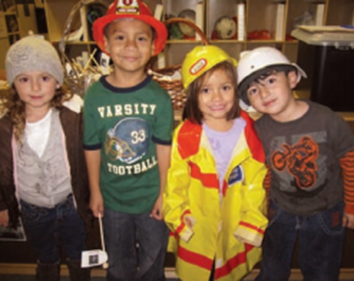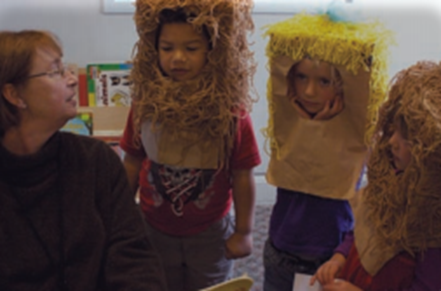A day after reading and discussing “The Three Billy Goats Gruff” during story time, Mr. Longfeather watches as a group of four-year-old children in his class pretend to be goats. The three children portraying the goats are trying to get into the “castle” as Juan, who is acting as a troll, stands guard. Mr. Longfeather is pleased to see that the children are using several objects he placed at the dramatic play area as props and scenery. Juan is having a great time and laughs as he uses a deep voice and makes funny “troll” faces.
After dramatic play time is over and the class has gathered on the rug, Mr. Longfeather listens as the children excitedly recount and describe what they did during dramatic play. “Juan was a funny troll,” says Kim. Juan adds, “And I used a walking stick.” The teacher responds, “That’s right, Juan. When you were the troll, you were using the paint stick as a ‘prop.’ A ‘prop’ is a thing actors use while pretending. I heard your deep troll voice and saw your scrunched troll face. I noticed that you were laughing as you made the faces. Did you enjoy making the faces?” The children ask if they can keep their “castle,” made from large blocks and fabric, in the dramatic play area. Mr. Longfeather agrees.
Several children begin arranging the dramatic play area of their preschool program to be a preschool itself. They excitedly call out their plans to play the teacher, the assistant teacher, the parents, and even themselves. As their teacher, Ms. Jackson, observes the activity, she notes that three children are evident leaders of this enterprise: Peter, Emma, and Jamila, all about four years old. The other children take an interest in this development and look in on the preparations without participating much—they occasionally toss in ideas or suggest the odd prop. Emma interrupts the proceedings by pronouncing, “Come sit down on the rug, class. I’m the teacher, and you are my children!” Peter and Jamila say nearly in unison, “No, I’m the teacher!” Some of the remaining children express a preference for who should be the teacher, including themselves.
As the project begins to fall to some grumbling and squabbling, Ms. Jackson steps in and says, “This looks really great—you’re building the whole classroom in just one corner of the room. I’ll bet you’d all like a chance to be the teacher. So let’s figure out how that can work.” Jamila says, “How do we tell who is the teacher?” Seizing a large plastic capital T from the alphabet box, Emma says, “With this!” The teacher nods her head and says, “That will be helpful because the word ‘teacher’ starts with the ‘t’ sound. Peter adds, “The person with this yellow T will be a teacher for a minute and show the class something a teacher does. And we’ll take turns.” As the children finish organizing the dramatic play area, Ms. Jackson sits down next to Lulu and Alejandro, who are just beginning to learn English, to help them understand the plan and participate.[6]



Feedback/Errata